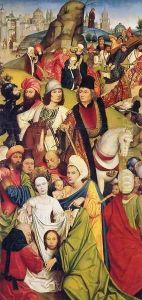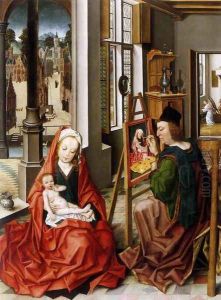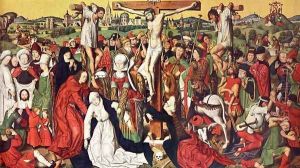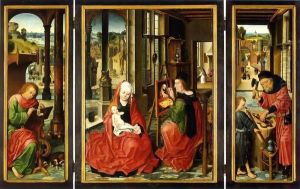Derick Baegert Paintings
Derick Baegert was a notable German painter active during the late Gothic period, whose career spanned the late 15th and early 16th centuries. Born around 1440, possibly in Wesel, located in the present-day North Rhine-Westphalia region of Germany, Baegert's artistic endeavors are a reflection of the transitional phase in European art from the medieval Gothic traditions to the early inklings of Renaissance influences. His works are particularly renowned for their meticulous detail, vivid portrayal of religious themes, and an emerging sense of perspective and individuality in the depiction of figures, which was innovative for his time.
Baegert's family was involved in the arts, with his father, likely named Derick Baegert the Elder, also being a painter. This familial background provided him with an apprenticeship from an early age in the techniques and materials used in late Gothic art. The Baegert workshop, presumed to be led by Derick and his brother, was responsible for several significant altarpieces and religious panels that have been attributed to them based on stylistic analysis, as very few works are signed. Among his most acclaimed works is the altarpiece for St. Lambert's church in Wesel, which showcases his skill in creating narrative depth and emotional intensity within the religious scenes depicted.
Baegert's style is characterized by its detailed landscapes and interiors, the precise rendering of figures and clothing, and a distinct use of color that adds a sense of realism and depth to his compositions. His works are considered crucial in understanding the development of German painting at a time when the artistic centers of Europe were beginning to shift towards the Renaissance ideals of Italy. Despite the limited number of surviving works definitively attributed to him, Baegert's influence is seen in the continuation of the detailed Gothic style and its gradual evolution into the Renaissance manner among German artists.
The exact date of Baegert's death is not known, but he is believed to have been active until at least 1509. His legacy is preserved in the collections of several European museums, where his paintings continue to be studied for their contribution to the late Gothic period's art and their role in the transition to Renaissance styles in Northern Europe. Baegert's work remains a testament to the enduring appeal of religious art in medieval Europe and its capacity to evolve and adapt to the changing tastes and artistic techniques of the early modern period.



